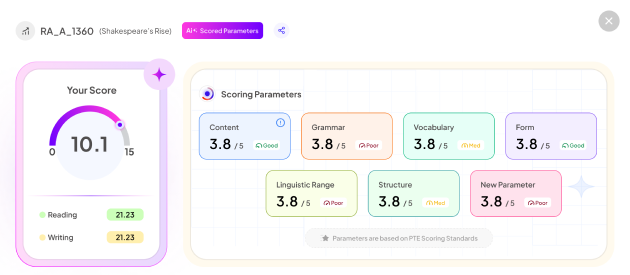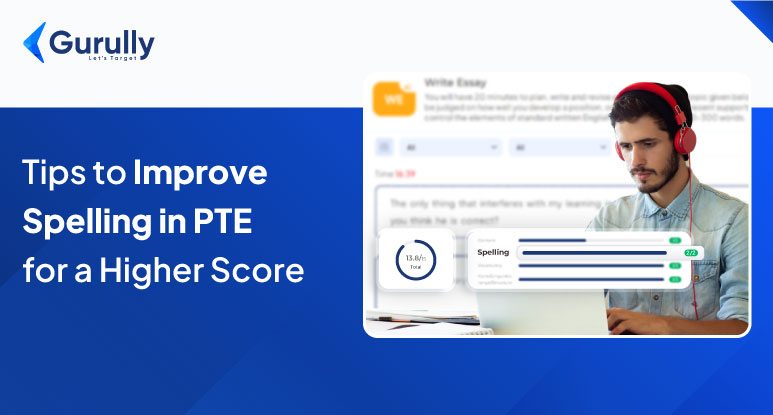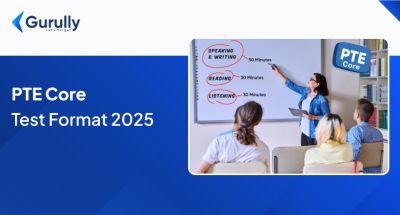Most of the time, students taking the PTE exam focus primarily on grammar, vocabulary, and coherence in tasks that involve writing responses. But there is one skill that can impact your writing scores if not taken care of properly – Spelling. No matter what your target score is, even the smallest mistake in spelling can hold you back. So, to avoid this mistake, here is everything you should take care of before attempting the PTE exam.
Why Spelling Matters in PTE Writing?
Spelling in the PTE exam, where writing responses is involved, plays a very important role as it affects the scoring criterion. Here is why it is so important:
- Machine Scoring Sensitivity: In the PTE exam, scoring is done through a computer (AI-scoring). So chances of overlooking small spelling errors are nil. Unlike a human examiner, the automated system will track even the smallest mistake, and you will lose points.
- Impression of Proficiency: If your responses have spelling errors, it shows a lack of language control, which reduces the credibility as a proficient English user.
- Impact on Other Sections: Spelling mistakes not only make you lose score in this skill but also in vocabulary. Sometimes spelling mistakes also change the flow, structure, and form of the sentence.
Even after the correct grammar of your response, repeated spelling mistakes can lower your overall score.
How Spelling is Scored in PTE?
Spelling is scored under the Enabling Skills section, and the scoring system rewards candidates who:
- Use standard American or British English spelling consistently.
- Avoid repeated or distracting errors.
- Demonstrate a good command of frequently misspelled academic words.
- Spelling Errors and Solutions by Score Range.
- Now let’s break down typical spelling issues and how to fix them based on your current PTE score range.
Start your free PTE mock test with Gurully and get AI-powered analysis for a personalized journey.


- Kickstart your PTE prep with a free AI-scored mock test
- Boost your score with in-depth analysis & smart recommendations
Score Range: Below 50
Common Issues:
- Committing errors in basic everyday words.
- Not using homophones correctly. (e.g., “their” vs. “there”)
- While writing using SMS or phonetic spelling (e.g., “u” instead of “you”)
Examples:
- Incorrect: definately, recieve, wich
- Correct: definitely, receive, which
Solutions:
- Learn spellings of basic words and use them in writing while framing sentences.
- Use spelling apps for practice and identifying mistakes. You can use Grammarly, WordUp, Magoosh, or Gurully, which has a dedicated vocabulary list with spelling for the PTE exam.
- Read English newspapers and magazines daily to learn spelling.
- Use dictation tools to hear and type words correctly
Score Range: 50–59
Common Issues:
- Errors while writing long words (e.g., “committment” vs. “commitment”)
- Switching between British vs American English frequently in the same sentence. (e.g., organise vs. organize mixed within the same essay)
- Not using suffixes or prefixes correctly (e.g., unpossible instead of impossible)
Examples:
- Incorrect: enviroment, goverment, occurence
- Correct: environment, government, occurrence
Solutions:
- Use only one English, either British or American, in sentences so that the AI can detect what you are using.
- Know about spelling rules and learn and practice them. (e.g., “i before e except after c”)
- Practice PTE writing tasks using a mock test on Gurully
- Use flashcards for common academic words
Score Range: 60–69
Common Issues:
- Getting confused between academic or technical vocabulary (e.g., “accomodate” instead of “accommodate”)
- False usage in the doubling of consonants (e.g., traning instead of training)
- Making capitalization mistakes, which are counted as errors in AI scoring. (e.g., Internet vs. internet)
Examples:
- Incorrect: occuring, arguement, refered
- Correct: occurring, argument, referred
Solutions:
- Review and learn academic vocabulary.
- Use sentence context to learn spellings instead of randomly learning vocabulary.
- Take detailed feedback from AI writing tools and tutors. You can also take separate writing section test on Gurully to identify where you are committing mistakes.
- Practice with apps like Anki or Quizlet
Score Range: 70 and Above
Common Issues:
- Spelling mistakes when writing complex words. (e.g., “persaverance” vs. “persaverance”)
- While typing fast, doing typos. (e.g., “wher” instead of “where”)
- Committing typos because of fast typing.
Examples:
- Incorrect: concious, neccessary, occurence
- Correct: conscious, necessary, occurrence
Solutions:
- Do not rush, proofread what you typed before submitting.
- Practice under timed conditions or practice on Gurully for real time exam simulation.
- Build a personal error log and revise it weekly.
To score high in the PTE exam, prepare with Gurully. Our smart platform offers a detailed vocabulary guide to help you learn words likely to appear in the test. You can practice with PTE academic mock test
designed to simulate the real exam experience. Additionally, explore section-wise tests and free question-based practice to improve specific skills. For expert tips and strategies to reach your target score, don’t forget to subscribe to our YouTube channel.
Conclusion
Spelling may seem minor, but in the PTE writing section, it can make a major difference. Since AI scoring picks up even the smallest errors, consistent accuracy is essential. Focusing on common issues within your score range and practicing smartly with Gurully, By doing you can avoid losing easy marks. By prioritizing spelling, you’ll be one step closer to achieving your target score.
FAQ:
Which spelling is used in PTE?
What is the 3-second rule in PTE?
Does PTE use American or British spelling?
What are dictation words in PTE?
Is PTE of two types?
Also Read:
- Learn How To Score High in “Content” of Speaking & Writing Section
- PTE Academic UKVI – Everything You Need To Know Before Booking The Exam
- PTE Core Score Chart: Know How To Set Your Target Score





